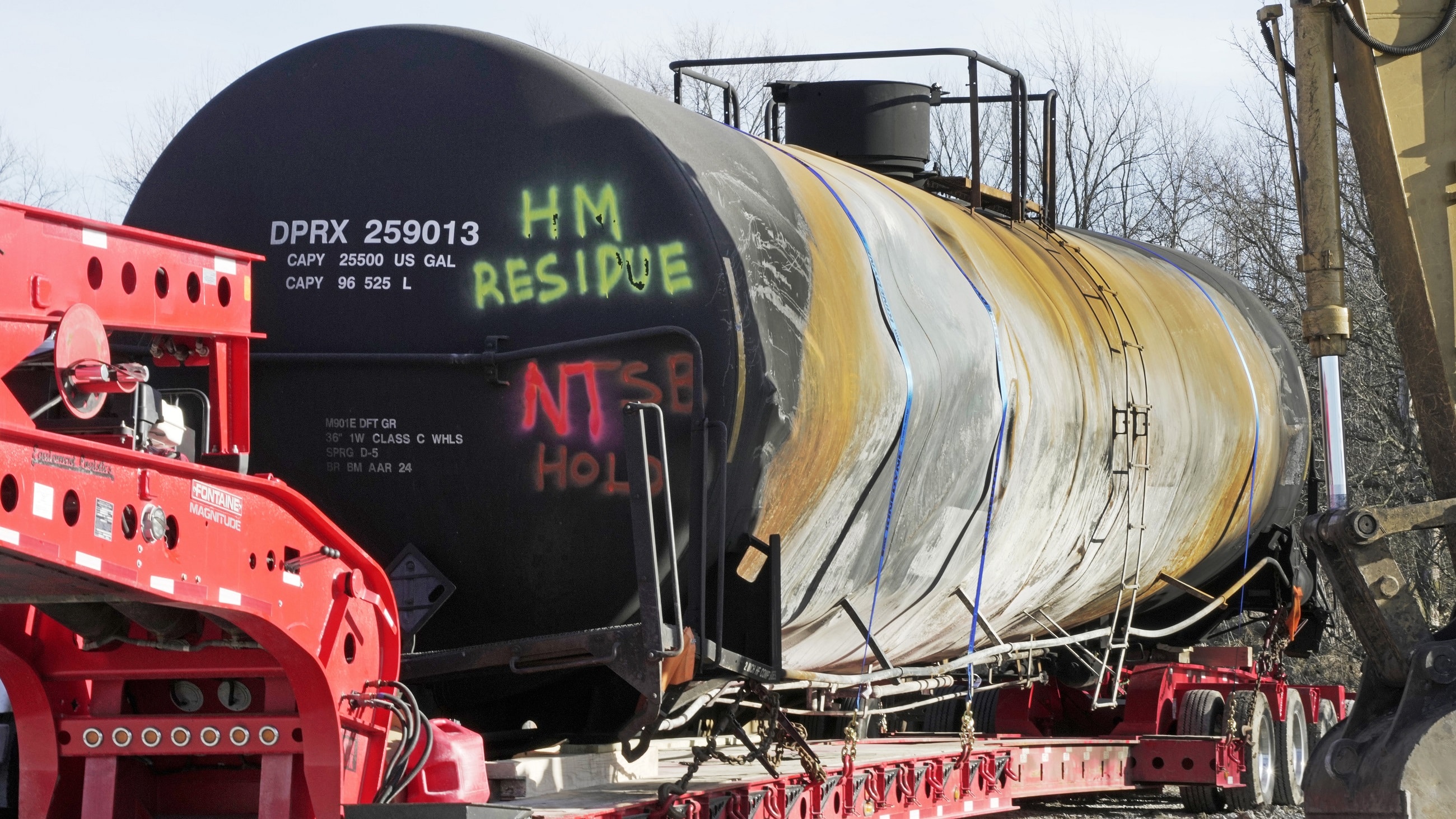Ohio Train Derailment: Prolonged Presence Of Toxic Chemicals In Buildings

Table of Contents
The Extent of Chemical Contamination
The derailment released a cocktail of toxic chemicals, including vinyl chloride, butyl acrylate, and ethylene glycol monobutyl ether, each posing significant health risks. Vinyl chloride, a known carcinogen, is particularly concerning due to its potential to cause liver cancer, brain tumors, and other serious illnesses. Butyl acrylate can cause respiratory irritation, skin sensitization, and eye damage, while ethylene glycol monobutyl ether can affect the nervous system and reproductive health. The impact extends far beyond the immediate derailment site. Air and water contamination, coupled with soil infiltration, led to the widespread presence of these chemicals in nearby buildings.
- Buildings Affected: The contamination affected a range of structures, including residential homes, commercial buildings, and even schools, raising serious concerns about long-term exposure for residents and students.
- Assessment Methods: Assessing the level of contamination in these buildings has proven challenging. Environmental agencies have employed various methods, including air sampling, soil testing, and wipe sampling, to determine the presence and concentration of the toxic chemicals.
- Mapping Challenges: Accurately mapping the spread of contamination has presented significant logistical hurdles, particularly considering the unpredictable nature of chemical dispersion and the limitations of current testing technologies. This makes pinpointing the full extent of the contamination a complex and ongoing process.
Health Concerns and Long-Term Effects
Residents exposed to the released chemicals have reported a wide range of health problems, both immediate and potentially long-term. Respiratory issues, such as coughing, shortness of breath, and wheezing, have been prevalent. Skin irritation, rashes, and eye problems have also been reported. The most concerning aspect is the potential for long-term health effects, including an increased risk of various cancers and neurological disorders.
- Reported Health Concerns: Reports from residents indicate a range of symptoms, from mild irritation to more severe respiratory illnesses and skin conditions. The long-term health impact remains largely unknown, requiring extensive monitoring and research.
- Long-Term Health Studies: Several long-term health studies are now underway or planned to monitor the health of residents and assess the lasting impact of the chemical exposure. These studies are critical for understanding the full extent of the health consequences and informing future public health interventions.
- Governmental Health Support: Government agencies are providing medical assistance and resources to affected residents, though the adequacy of this support remains a subject of debate and ongoing concern.
Remediation Efforts and Challenges
Cleaning up the contamination presents significant technical and logistical challenges. The persistent nature of some of these chemicals makes complete removal difficult and potentially costly. Remediation efforts are underway, but the scale of the problem and the complexity of the cleanup process mean that the task will likely take years.
- Remediation Techniques: Various remediation techniques are being employed, including soil excavation, air scrubbing, and specialized cleaning of affected surfaces. The effectiveness of these techniques varies depending on the specific chemical and the extent of contamination.
- Obstacles Encountered: Challenges include the sheer volume of contaminated materials, the need for specialized equipment and expertise, and the difficulty of accessing hard-to-reach areas.
- Funding Challenges: The financial resources required for a comprehensive cleanup are substantial, raising concerns about the long-term costs and the potential for inadequate funding to hinder effective remediation.
The Role of Government Agencies and Accountability
The response from federal, state, and local agencies to the Ohio train derailment has been subject to intense scrutiny. Criticisms have centered on the perceived slowness and inadequacy of the initial response, as well as questions about the transparency and effectiveness of subsequent cleanup efforts. The legal implications are substantial, with potential lawsuits and investigations targeting the railroad company and various governmental agencies.
- Governmental Actions: Federal, state, and local agencies have undertaken various actions, including health monitoring, environmental assessments, and the implementation of cleanup efforts. The coordination and effectiveness of these actions have been questioned.
- Investigations and Accountability: Investigations into the cause of the derailment and the subsequent handling of the situation are underway. The legal accountability of the involved parties remains a significant concern, with potential for significant legal ramifications.
- Legal Actions: Several lawsuits have already been filed, and more are expected, as residents seek compensation for damages and hold responsible parties accountable.
Conclusion
The Ohio train derailment and the subsequent release of toxic chemicals into the environment present a grave and prolonged threat to the health and well-being of affected communities. The lingering presence of these chemicals in buildings necessitates continued monitoring, thorough investigation, and comprehensive cleanup efforts. The significant health concerns, coupled with the substantial challenges in remediation, underscore the urgent need for transparency, accountability, and decisive action from responsible parties. Stay informed about the latest developments concerning the Ohio Train Derailment Toxic Chemicals issue by following reputable news sources and engaging in community discussions. Demand transparency and accountability to ensure the safety and well-being of all those impacted. Demand a complete and thorough cleanup of all toxic chemicals released from the Ohio train derailment.

Featured Posts
-
 O Kosmos Toy Goyes Anterson Zontaneyei Se Ekthesi Sto Londino
May 28, 2025
O Kosmos Toy Goyes Anterson Zontaneyei Se Ekthesi Sto Londino
May 28, 2025 -
 Best Personal Loan Rates Today Secure Your Financing Now
May 28, 2025
Best Personal Loan Rates Today Secure Your Financing Now
May 28, 2025 -
 Cristiano Ronaldo Nun Carpici Marka Guecue Detayli Analiz
May 28, 2025
Cristiano Ronaldo Nun Carpici Marka Guecue Detayli Analiz
May 28, 2025 -
 Za Kulisami Novogo Filma Uesa Andersona
May 28, 2025
Za Kulisami Novogo Filma Uesa Andersona
May 28, 2025 -
 Angels Vs Pirates Mike Trout Kenley Jansen And Getaway Game Start Time
May 28, 2025
Angels Vs Pirates Mike Trout Kenley Jansen And Getaway Game Start Time
May 28, 2025
Latest Posts
-
 De Laatste Dagen Van Het Derde Rijk Een Beoordeling Van Bert Natters Roman
May 31, 2025
De Laatste Dagen Van Het Derde Rijk Een Beoordeling Van Bert Natters Roman
May 31, 2025 -
 Analyse Van Bert Natters Concentratiekamproman Sterktes En Zwaktes
May 31, 2025
Analyse Van Bert Natters Concentratiekamproman Sterktes En Zwaktes
May 31, 2025 -
 Klimatolerans Noevenyfajtak Valasztasa Az Alfoeldi Termesztesben
May 31, 2025
Klimatolerans Noevenyfajtak Valasztasa Az Alfoeldi Termesztesben
May 31, 2025 -
 Bert Natters Concentratiekamproman Een Indrukwekkend Vermoeiend Portret Van De Nazidagen
May 31, 2025
Bert Natters Concentratiekamproman Een Indrukwekkend Vermoeiend Portret Van De Nazidagen
May 31, 2025 -
 April Outlook Update Recent Developments And Forecasts
May 31, 2025
April Outlook Update Recent Developments And Forecasts
May 31, 2025
